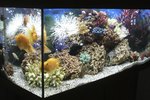Anemones are fascinating coral reef animals, which possess stinging cells to capture their prey. These strikingly colored creatures need optimal water parameters and intense lighting when housed in a home aquarium. Sea anemones also require moderate to strong water movement and must be fed at regular intervals. These jelly-like reef marine invertebrates are large bodied animals and will quickly pollute an aquarium once they die. Aquarists must monitor their anemones closely and remove ill animals from the aquarium as soon as possible.
Look closely to see if the foot or basal disk of the anemone is coming loose from the rock or coral rubble on which it is attached. Dying anemones begin to detach and in some cases, will become completely loose and will tumble around in the aquarium. In other cases, the foot will become partially loose as the animal is dying, but the anemone will still remain it its original position after death.
Look at the anemone’s mouth, which is in the center of the animal’s body, surrounded by tentacles. Anemones that are dying, invert their mouths and it appears as if the animal’s insides are pouring out.
Observe the anemone’s tentacles. They should not be deflated for extended periods of time. If your anemone’s tentacles remain deflated for more than three or four days, you can begin to suspect that the animal is ill and is in the process of dying, or is already dead.
Look at the size of the anemone. Dying anemones begin to shrink. Anemones that are close to death are typically considerably smaller than they used to be. Healthy anemones will periodically expel stale water from within their body and will deflate during this time. These anemones should begin to inflate once again after a day or two at the most. An anemone which remains deflated for longer than a few days, is probably dying, or is already dead.
Examine the body of the anemone. If pieces of tissue are sloughing off, the anemone is terminally ill, if not already dead.
Observe the color of your anemone. Anemones are typically vividly colored and animals which are loosing their color are no longer healthy. These animals are loosing the Zooxanthellae in their tissue, through which they photosynthesize. These animals will die shortly unless conditions in the aquarium are immediately improved.
Look at the clarity of your aquarium water. The water in an aquarium in which an anemone has died will be cloudy, often exhibiting a milky hue.
References
Resources
Photo Credits
-
Hailshadow/iStock/Getty Images
Writer Bio
Virtually growing up in a computer repair shop, Naomi Bolton has held a passion for as long as she can remember. After earning a diploma through a four year course in graphic design from Cibap College, Bolton launched her own photography business. Her work has been featured on Blinklist, Gameramble and many others.




